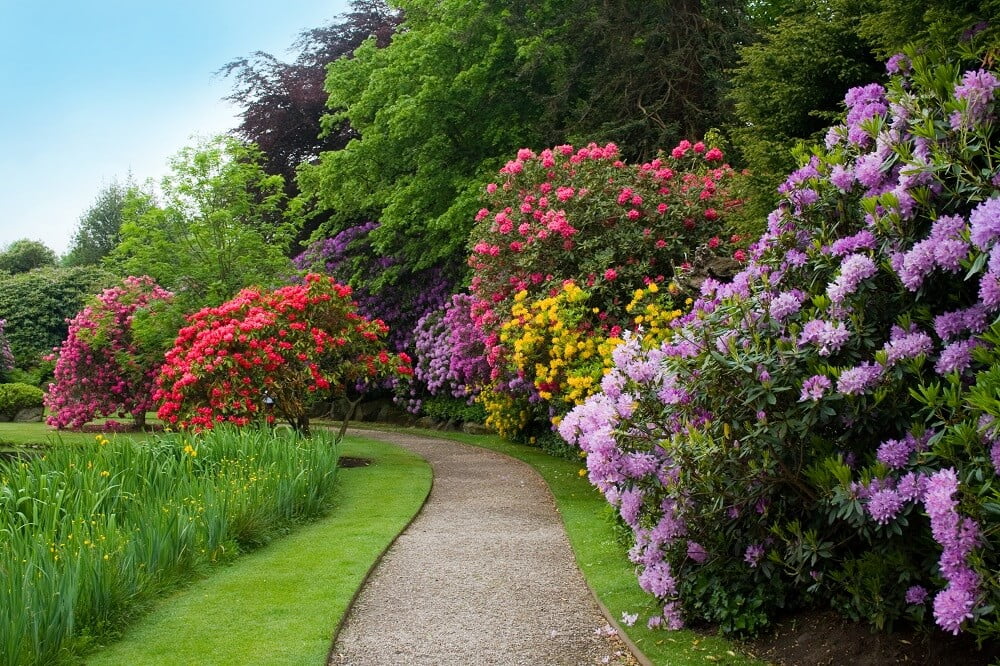
Wondering, what to use for borders in the garden? The choice of materials is wide, and each has its own unique advantages that make your garden even more attractive. Materials for garden borders include stone, wood, metal, brick or plastic. Each offers a different style and a variety of applications.
Stone is ideal for those who want to create a natural and rustic environment, while wood adds warmth and is ideal for Scandinavian-style gardens. Brick adds a modern look, while plastic is lightweight and easy to install.
First and foremost, whatever the choice, garden edging should fulfil its primary role — to separate the different parts of the garden, protect the plants and facilitate tidiness. Diverse materials make it possible to create original compositions and give gardens an individual character.
Plastic edging is becoming increasingly popular among gardening enthusiasts due to its numerous advantages. Above all, they are characterised by their high flexibility, which allows them to easily adapt to the most complex shapes and lines in the garden. In addition, they are extremely resistant to changing weather conditions, which guarantees that they will retain their aesthetic appearance for a long time without the need for frequent renewal or replacement. Plastic is not subject to rotting processes or attractive to pests, making it an excellent alternative to traditional materials such as wood. Ease of installation is another argument in favour of their choice; plastic edging can be installed quickly and efficiently, requiring no specialist tools or skills. It is also worth noting the ecological aspect — by choosing edging made from recycled plastic, we contribute to reducing the amount of waste and promote a sustainable approach to managing the space around us.
Application perimeter around trees or shrubs has many benefits, both aesthetic and practical. One of the most important aspects is the protection of the root system. The borders reduce the risk of root damage during gardening work, which is crucial for the health and growth of trees. In addition, they make it easier to keep things tidy by preventing grasses, rhizomes and weeds from growing right next to the trunk. This makes mowing easier.
They are undoubtedly one of the most important elements of any garden, regardless of its style or size. The main function of the borders is of course to separate the different parts of the garden, but thanks to the variety of materials available, they can also become an important decorative element, emphasising the character of the garden and harmoniously connecting the different parts.
If you are wondering, how to make borders in the garden, the first step is to choose the right material. As we mentioned above, it can be stone, wood, metal or brick, but the most popular is plastic — it all depends on the style of your garden. The next step is to prepare the site for the edging — it needs to be marked and cleared of any rubbish, grass or stones that may hinder the installation. The next step is to install the edging itself. Remember to keep adequate clearance from the tree roots so as not to interfere with their natural functioning. Let us also take care that the edging does not restrict the flow of water.
A properly selected and installed border is a guarantee not only of the beautiful appearance of our garden, but also of its health and tidiness. Remember that patience and thoroughness are the key qualities of a good gardener, so do everything step by step and enjoy the beautiful end result.
Garden edging is an essential element in creating a thoughtful and harmonious outdoor space. Their use translates not only into an aesthetic finish of the garden, but also into its functionality. Thanks to them, it is possible to clearly separate individual zones, such as flowerbeds, paths or lawns, which facilitates space organisation and plant care. Edging also helps to maintain order by preventing the spread of vegetation and maintaining boundaries between different parts of the garden. Furthermore, they protect against soil erosion and maintain the shape of the arrangement, even in difficult weather conditions. The choice of edging material allows it to match the style of the garden and the owner’s individual preferences. From the classic elegance of stone to the modern look of plastic, the possibilities are almost endless. It is also worth emphasising that appropriately selected edging can emphasise the natural beauty of plants and garden compositions, constituting their subtle background or a striking frame. As a result, edging is a key element that helps to create a coherent and attractive space, while ensuring that it is long-lasting and easy to maintain.
Looking for ideas, what to use for borders in the garden? We have prepared some inspiring ideas to help you choose the perfect solution. Garden borders open up a wide range of design possibilities, allowing us to create flowerbeds and paths in unique, non-standard shapes. Thanks to them, we can easily separate various zones in the garden, creating both simple, geometric lines and more fluid, organic forms. Using the borders, we can design flowerbeds that look like free-flowing streams of colour, or paths reminiscent of winding forest tracks, which will introduce an element of mystery and naturalness to the garden.
A variety of edging materials and textures can also be used for inspiration, bringing the garden to life and adding character. When creating paths, you can play with contrasts — the soft lines of the lawn broken by the sharp edges of the stone edging will create an intriguing visual effect. The creative use of edging in the garden allows you to personalise your space and express your individual aesthetic preferences, allowing each garden to become a unique work of applied art.